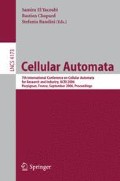Abstract
We give a synthetic and formalized account of relationships between cellular automata (CA) and differential equations (DE): Numerical schemes and phase portraits analysis (via cell-to-cell mappings) can be translated into CA, and compositions of differential operators and phase portraits induce CA compositions. Based on DE, CA can be tuned according to discretization parameters so that faithful CA sequences can be built describing qualitative as well as quantitative solutions.
Access this chapter
Tax calculation will be finalised at checkout
Purchases are for personal use only
Preview
Unable to display preview. Download preview PDF.
References
Ames, W.F.: Numerical Methods for Partial Differential Equations, 2nd edn. Academic Press, London (1977)
Barkley, D.: A model for fast computer simulation of waves in excitable media. Physica D 49, 61–70 (1991)
Choppard, B., Droz, M.: Cellular Automata Modeling of Physical Systems. Cambridge University Press, Cambridge (1998)
Chueh, K., Conley, C., Smoller, J.: Positively invariant regions for systems of nonlinear parabolic equations. Indiana Univ. Math. J. 26, 373–392 (1977)
Delorme, M., Mazoyer, J.: Cellular Automata, A Parallel Model. Kluwer Academic Publishers, Dordrecht (1999)
Gerhardt, M., Schuster, H., Tyson, J.J.: Cellular automaton model of excitable media II & III. Physica D 46, 392–426 (1990)
Greenberg, J.M., Hassard, B.D., Hastings, S.P.: Pattern formation and periodic structures in systems modeled by reaction-diffusion equations. Bull. of the AMS 6, 1296–1327 (1978)
Grindrod, P.: Patterns and Waves. Clarendon Press, Oxford (1991)
Hsu, C.S.: Cell-to-Cell Mapping, A Method of Global Analysis for Nonlinear Systems. Springer, Heidelberg (1987)
Hubbard, J.H., West, B.H.: Differential Equations. A Dynamical System Approach. Parts I and II. Springer, Heidelberg (1995)
Keener, J.P.: A geometrical theory for spiral waves in excitable media. SIAM Journ. Appl. Math. 46(6), 1039–1056 (1986)
Kuipers, B.: Qualitative Reasoning. MIT Press, Cambridge (1994)
Kuptsov, P.V., Kuznetsov, S.P., Mosekilde, E.: Particle in the Brusselator model with flow. Physica D 163, 80–88 (2002)
Murray, J.D.: Mathematical Biology. Springer, Heidelberg (1993)
Oran, E.S., Boris, J.P.: Numerical Simulation of Reactive Flow. Elsevier, Amsterdam (1987)
Rauch, J., Smoller, J.: Qualitative theory of the Fitzhugh-Nagumo equations. Adv. in Math. 27, 12–44 (1978)
Shadwick, B., Bowman, J., Morrison, P.: Exactly conservative integrators. SIAM J. Appl. Math. 59 (1999)
Sherratt, J.A.: Periodic travelling waves in a family of deterministic cellular automata. Physica D 95, 319–335 (1996)
Strikwerda, J.C.: Finite Difference Schemes and Partial Differential Equations, 2nd edn. SIAM, Philadelphia (2004)
Toffoli, T., Margolus, N.: Cellular Automata Machines: a New Environment for Modeling. MIT Press, Cambridge (1987)
Tokihiro, T., Takahashi, D., Matsukidaira, J., Satsuma, J.: From soliton equations to integrable cellular automata through a limiting procedure. Physic. Rev. Let. 76(18), 3247–3250 (1996)
Tyson, J.: Singular perturbation theory of traveling waves in excitable media. Physica D 32, 327–361 (1988)
Weimar, J.R.: Simulation with Cellular Automata. Logos-Verlag, Berlin (1998)
Weimar, J.R., Boon, J.P.: Class of cellular automata for reaction-diffusion systems. Physical Review E 49(2), 1749–1751 (1994)
Wolfram, S.: Twenty problems in the theory of cellular automata. In: Physica Scripta Proceedings of the 59th Nobel Symposium, pp. 170–183 (1985)
Wolfram, S.: A New Kind of Science. Wolfram Media Inc. (2002)
Yanenko, N.N.: The Method of Fractional Steps. Springer, Heidelberg (1971)
Author information
Authors and Affiliations
Editor information
Editors and Affiliations
Rights and permissions
Copyright information
© 2006 Springer-Verlag Berlin Heidelberg
About this paper
Cite this paper
Narbel, P. (2006). Qualitative and Quantitative Cellular Automata from Differential Equations. In: El Yacoubi, S., Chopard, B., Bandini, S. (eds) Cellular Automata. ACRI 2006. Lecture Notes in Computer Science, vol 4173. Springer, Berlin, Heidelberg. https://doi.org/10.1007/11861201_16
Download citation
DOI: https://doi.org/10.1007/11861201_16
Publisher Name: Springer, Berlin, Heidelberg
Print ISBN: 978-3-540-40929-8
Online ISBN: 978-3-540-40932-8
eBook Packages: Computer ScienceComputer Science (R0)

